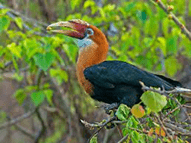History and Art and Culture
Context: Hornbill Festival is an annual festival of Nagaland. The vibrant festival takes place mostly in the first week of December every year. The main venue of the Hornbill Festival, 2022 is Kohima, the capital of Nagaland.
- The festival organized by Nagaland Government is an annual tourism promotional event to showcase the state’s traditional and rich cultural heritage in all its ethnicity, diversity and grandeur.
- The objective is to encourage inter-tribal interaction and to promote cultural heritage of Nagaland.
- Highlights of the Hornbill Festival include witnessing the cultural performance of different tribes of Nagaland and Northeastern States, indigenous games, city tour, night carnival, art exhibition, photo-fest and many more.
- One of the major highlights of this festival is the Hornbill International Rock Festival where local and international rock bands perform.
Hornbills:
- India is home to nine species of hornbills: three of them, the wreathed hornbill (Aceros undulatus), the brown hornbill (Anorrhinus austeni) and the Rufous-necked hornbill (Aceros nipalensis) great hornbill is the state bird of Arunachal Pradesh and Kerala. India also has Narcondam Hornbill, found only on the island of Narcondam.
- Hornbill festival celebrated in Nagaland is named after the bird – Hornbill which is the most revered and admired bird for the Nagas.
- Hornbills used to be hunted for their casques — upper beak — and feathers for headgear despite being cultural symbols of some ethnic communities in the northeast, specifically the Nyishi of Arunachal Pradesh.
- But a 20-year-old conservation programme entailing the use of fibreglass beaks reduced the threat to the birds to a large extent.
Important Hornbill species:
Great Hornbill:

- IUCN Red List: Near threatened.
- Largest of all hornbills in India.
- Found in a few forest areas in Western Ghats and the forests along Himalayas.
Rufous-necked Hornbill:

- IUCN Red List: Vulnerable
- Has Northern-most extent, ranging from North-eastern India to Mahananda Wildlife Sanctuary in West Bengal.
Narcondam Hornbill:

- IUCN Red List: Endangered
- Endemic to Indian island of Narcondam in Andamans.
- Smallest home range out of all species of Asian hornbills.
Malabar Pied Hornbill:

- IUCN Red List: Near Threatened
- Common resident breeder in India and Sri Lanka.
- Habitat: Evergreen and moist deciduous forests often near human settlements.
Note:
- Tsiiphie: Traditional Naga headgear
- Amula kaxa: Naga shawl
- In Pakke Tiger Reserve, flocks of up to 60 Great Hornbills have been seen roosting at a single site with more than 100 Wreathed Hornbills in the winter (non-breeding season).
- Lies in the foothills of the eastern Himalaya in the East Kameng district of Arunachal Pradesh. It is also known as Pakhui Tiger Reserve.
- Falls within the Eastern Himalaya Biodiversity Hotspot.
- Known for its amazing sightings of four resident hornbill species.
- India is home to nine species of hornbills. three of them, the wreathed hornbill (Aceros undulatus), the brown hornbill (Anorrhinus austeni) and the Rufous-necked hornbill (Aceros nipalensis)great hornbill is the state bird of Arunachal Pradesh and Kerala.
- It is ‘vulnerable’ under the IUCN Red list.
- Hornbill festival celebrated in Nagaland is named after the bird – Hornbill which is the most revered and admired bird for the Nagas.
- India plans to showcase Nagaland’s Hornbill Festival during its G20 presidency.
About the size of a turkey, the southern ground hornbill is the largest species of hornbill on Earth. It can fly up to 18 miles an hour and has an impressive wingspan that reaches about four feet across. The bird is recognizable by its jet-black feathers, yellow eyes, and bright red throat.
Source: PIB














